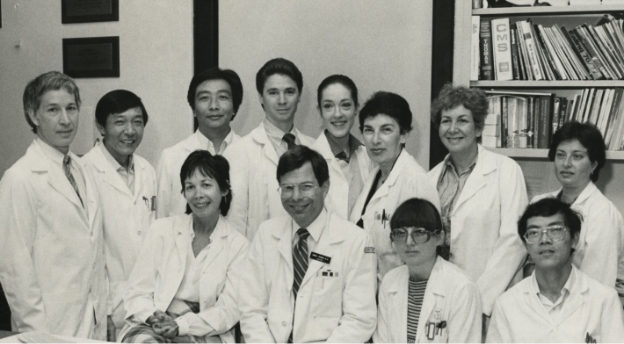The mission of the Samuel Waxman Cancer Research Foundation (SWCRF) is to eradicate cancer by funding collaborative cross-institutional research to identify and correct abnormal gene function that cause cancer. This research is the basis for developing minimally toxic treatments for all patients with cancer.

SWCRF Founder and CEO Dr. Samuel Waxman on leading a cancer treatment revolution

How we brought together the world’s brightest scientific minds to find a cancer cure
HOW THE FOUNDATION GOT ITS START
In the early 1970s, notable oncologist and science investigator Samuel Waxman, M.D. met Barry Finn, the uncle of a young man who he had successfully treated for Hodgkin’s disease. Mr. Finn asked Dr. Waxman how he got funding for my research—and was shocked to learn that hospitals do not fund researchers. If Dr. Waxman did not receive outside grants, he could not perform research. Mr. Finn asked Dr. Waxman if he had ever thought of creating a Foundation. Of course, he had not.
Then, Mr. Finn arranged for Dr. Waxman to meet his father-in-law, Irving Alpert, who was in the fashion and textile business. "I remember the day I walked into their showroom in the garment district. Irving had a cigar in his mouth and sat at the head of a big table, surrounded by five other men," recalls. Dr. Waxman. "He said, 'I hear you do good work. I want to help.'"
Then Mr. Alpert turned to his lawyer and said, "Write Dr. Waxman a check for $25,000," and then turned to Dr. Waxman and said, "We'll name the Foundation after you. By the way, what's your name?"
And that was how the SWCRF got its name and started funding innovative research.
Dr. Waxman and the SWCRF believes that science works better with collaboration. Each lab has its particular strength and expertise. Each science investigator has developed his or her specialty and expertise. Place two or more labs together with two or more investigators—and we all benefit.
Connecting multiple labs and investigators together - who might not typically join otherwise - is the way the SWCRF works. We find researchers with talent who have a track record—we start them working on their own with the understanding that they will have to collaborate. We believe this helps us move science to clinical importance rapidly.
In the late 1970s, Dr. Waxman initiated a collaboration with researchers in China, at a time when international relations between the two countries began to thaw out.
Several visiting scientists from Shanghai Second Medical University were working in Dr, Waxman’s lab at the Icahn School of Medicine at Mount Sinai. The researchers were hungry for science and eager to learn. In Dr. Waxman’s lab, they learned about cell differentiation and reprogramming—and when they went back to China, they started to work in this area. The SWCRF sent equipment and agents back to China that investigators did not have at that time.
Dr. Waxman was studying differentiation as a treatment for malignant disease—in particular, investigating the use of retinoic acid, a vitamin A derivative, as a treatment for acute promyelocytic leukemia (APL). In the early 1980s, he established a close working relationship with Wang Zhen Yi, who was then President of the Shanghai Second Medical University and Director of the Shanghai Institute of Hematology. Together, Dr. Waxman and Dr. Wang planned the use of trans-retinoic acid to treat APL. Within a short time, Dr. Wang and his group used a form of trans-retinoic acid that was available in China (but not in the U.S.) that proved to be effective. They treated 15 patients, all of whom went into remission.
Dr. Waxman continued to work with another scientist, Dr. Zhu Chen, who took over the leadership of the Shanghai Institute of Hematology and became one of the significant health leaders in China. Dr. Chen and Dr. Waxman, working with others, explored the use of arsenic trioxide, a natural substance that had been used medicinally in China for over 2,400 years, to treat APL in patients when retinoic acid failed. Arsenic trioxide was especially effective since it not only caused leukemia cells to function like healthy cells, but also made the cancer cells die.
By 2005, the SWCRF had shown that a combination therapy— that included both retinoic acid and arsenic trioxide—cured 95% of patients with APL. It is now the standard treatment for this disease—and most patients need no chemotherapy.

A HISTORY OF ACHIEVEMENTS
- The SWCRF was founded in 1976 by Samuel Waxman, M.D., a notable oncologist and physician-scientist at the Icahn School of Medicine at Mount Sinai.
- Since its inception, the SWCRF has funded approximately $100 million in cancer research.
- The SWCRF focuses on funding cutting-edge research that uncovers cancer-causing abnormal gene function.
- A key goal of SWCRF is to develop minimally toxic treatments based on correcting cancer-causing gene function associated with all forms of cancer.
- The SWCRF funds a research collaboration in China that leads to the discovery of a treatment for a form of leukemia and improving patient survival rate from less than 25% to greater than 95%.
- Through the SWCRF "Institute Without Walls", we fund a network of 30 researchers who are some of the brightest scientific minds in North America, Asia, and Europe.
